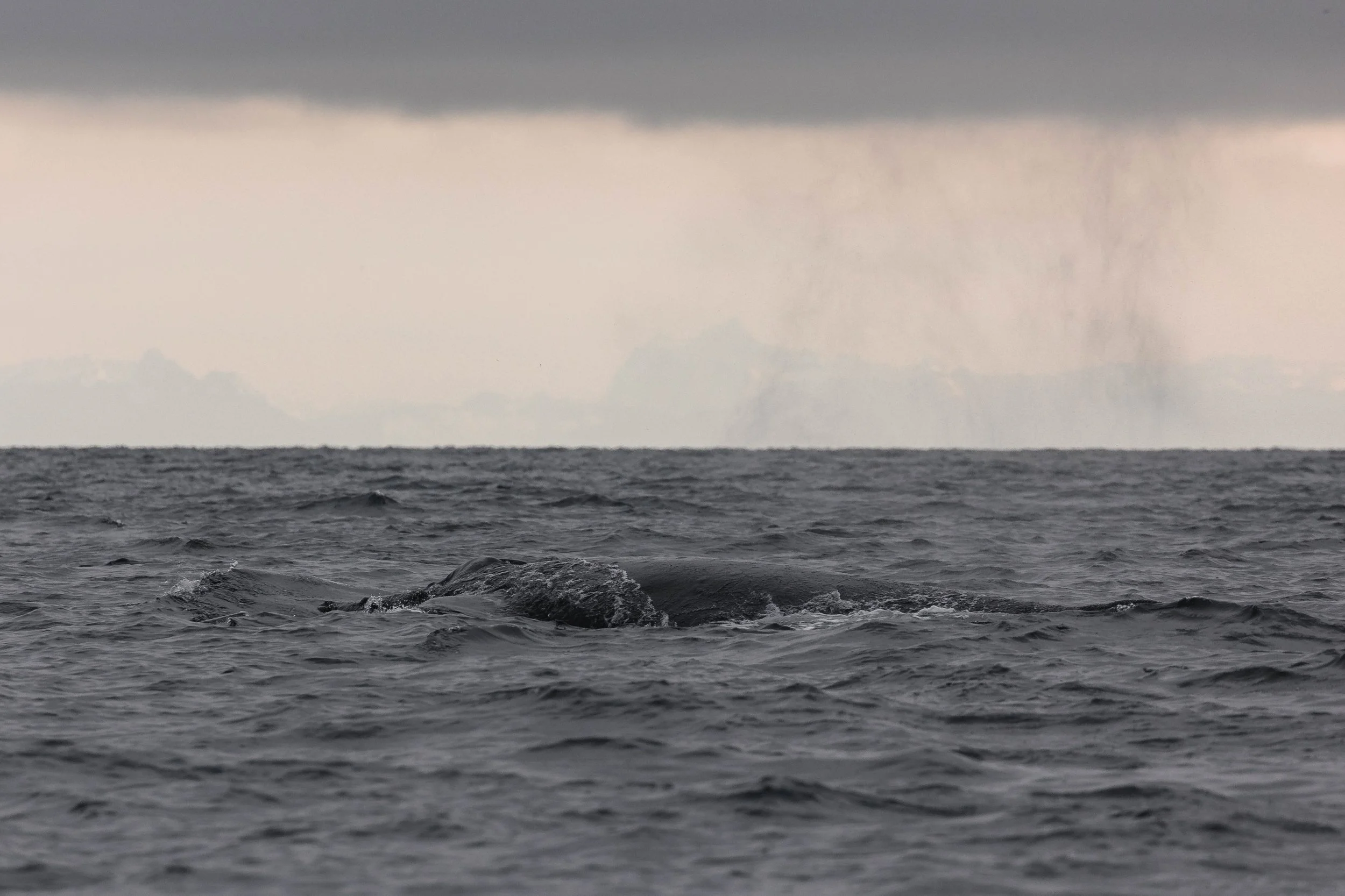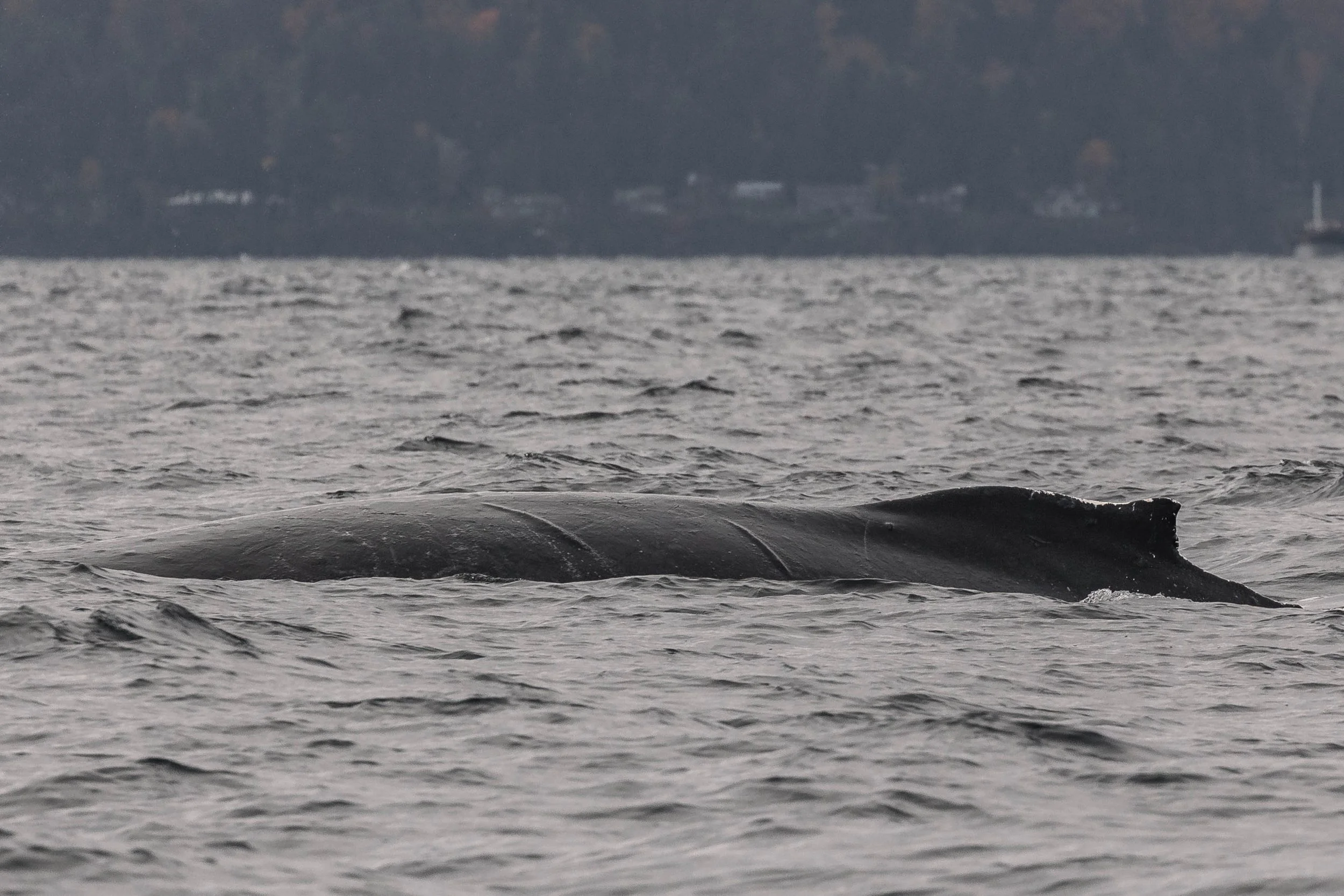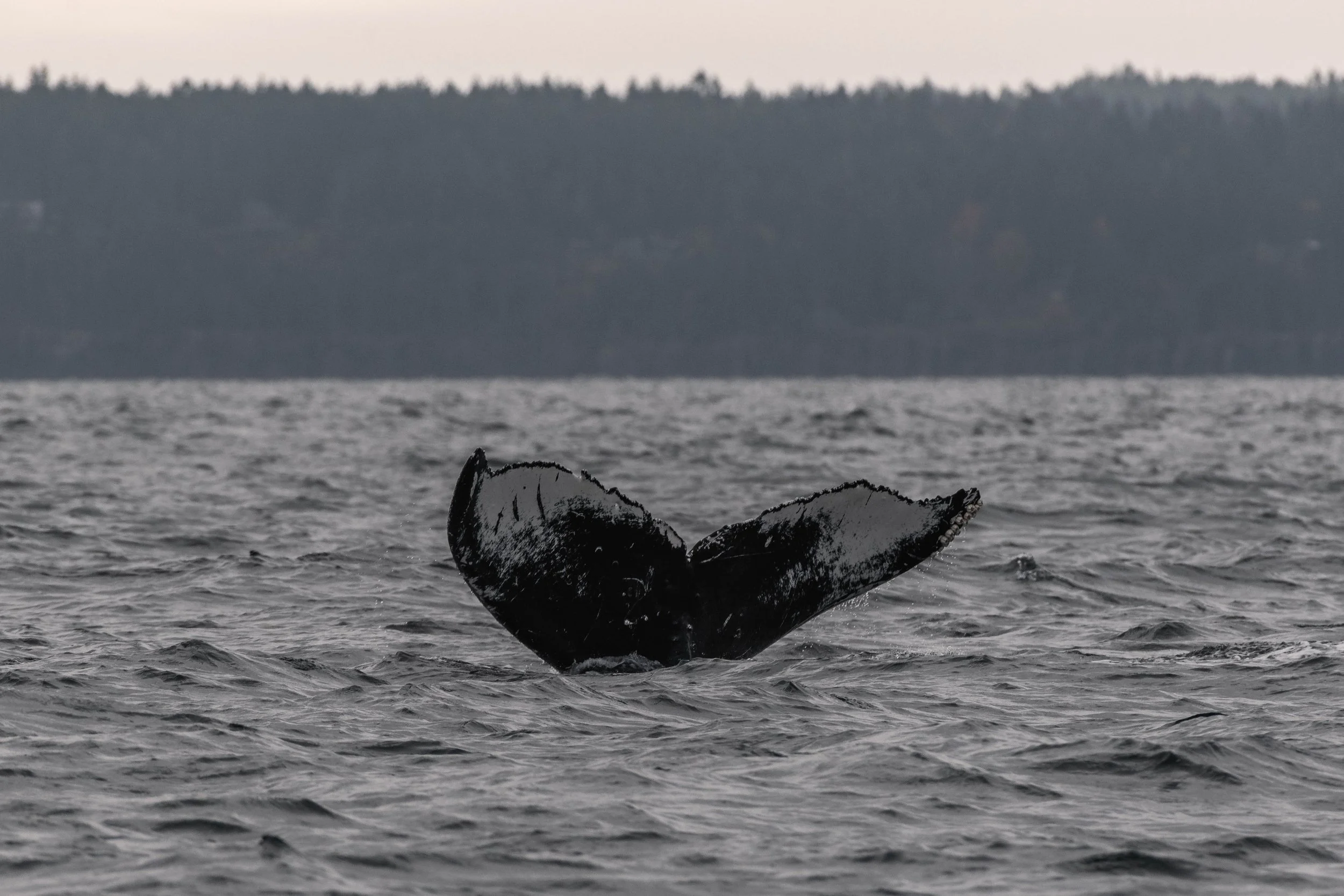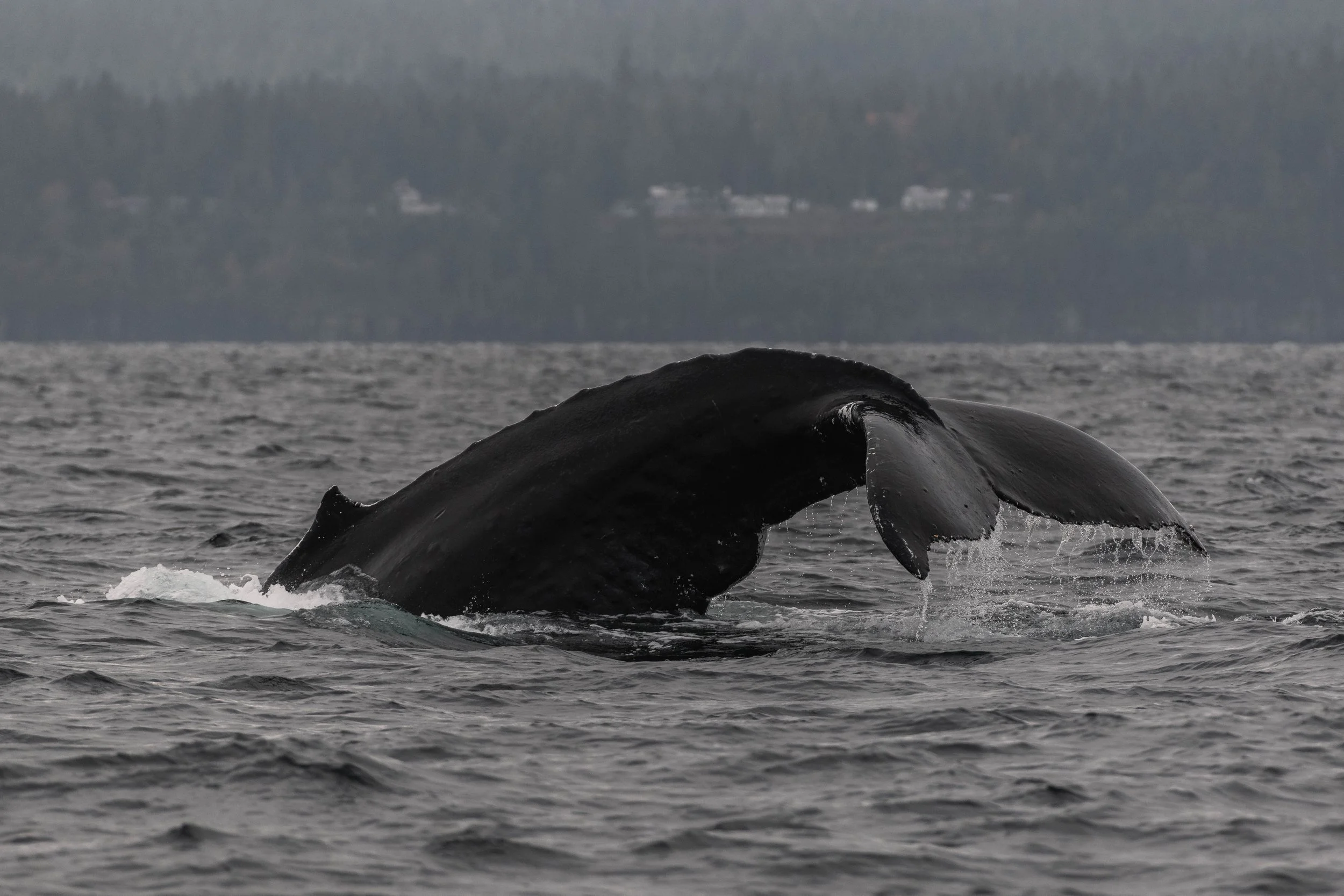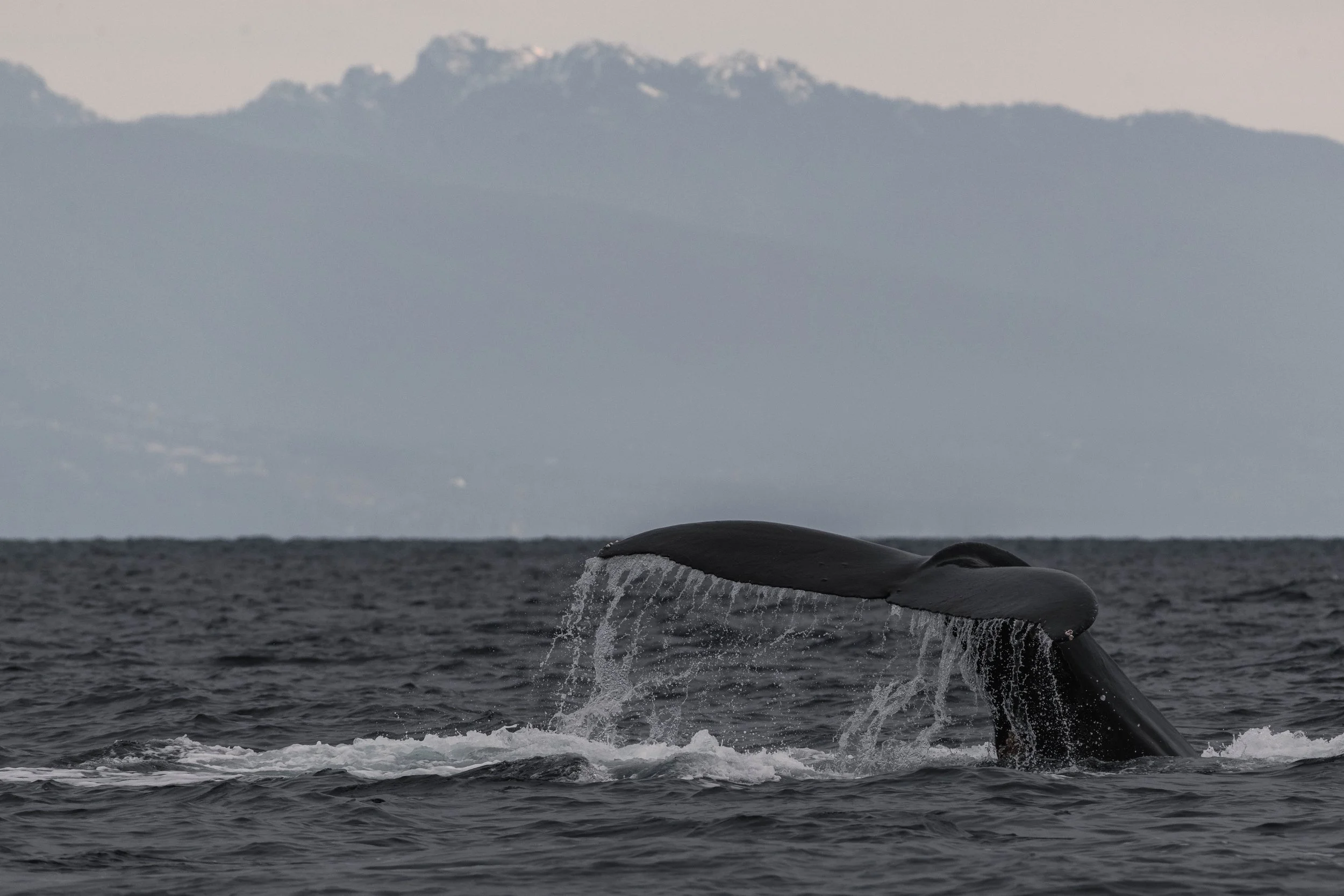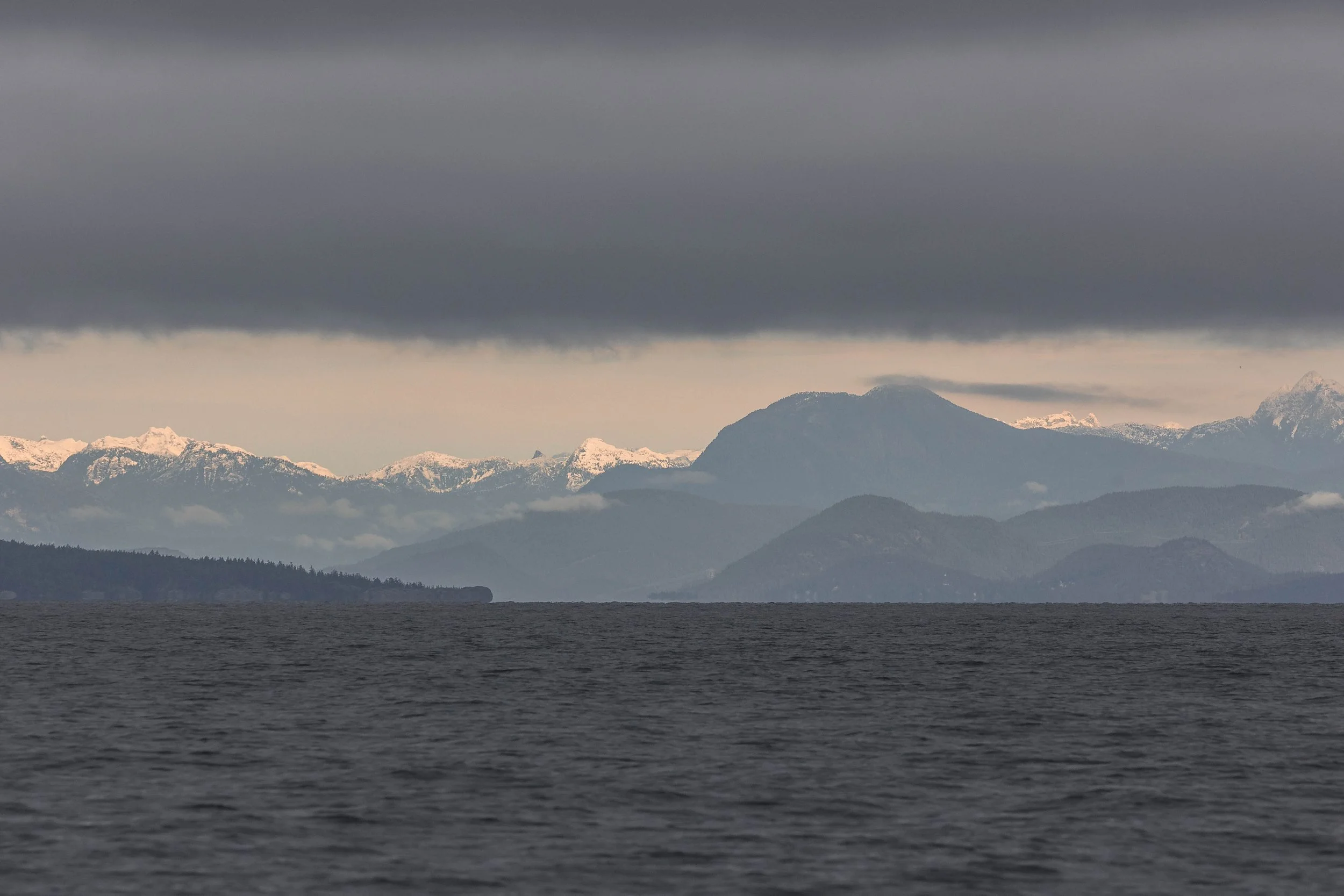October 30, 2025 - A trifecta of humpbacks in the Strait.
Two of our vessels headed out today under dramatic skies, the kind of quintessential West Coast weather that makes every trip feel like a cinematic experience. Though the winds were calm, the clouds were heavy and brooding, creating a breathtaking backdrop across the Salish Sea. Snow-dusted peaks framed the horizon, and low-hanging mist hugged the islands, a perfect setting for an afternoon of exploration.
Our journey began in the Strait of Georgia, heading south along the shores of Gabriola Island. With no early signs of activity close to shore, both crews decided to venture farther into the open Strait, scanning the moody horizon for signs of life. Days like this can be both challenging and rewarding, while the dark clouds often make a whale’s blow stand out brilliantly, today they seemed to melt into the mist. Still, our crew’s trained eyes caught something unusual. After a few moments of patient observation (and some strategic squinting), we confirmed what we were hoping for, humpbacks!
A pair of humpback whales were surfacing together, their movements perfectly in sync. One whale gave us high flukes with each dive, while the other rolled low on the surface, keeping its tail just below the waves. Luckily, they bore a distinctive feature, a white scar along their dorsal fin. It was Graphite (BCX2077) with what we lovingly call a lazy tail! Checkmate (BCY1104) was our fluker, lifting their tail with every dive.
Humpback whales can be identified by the unique markings on the underside of their tail flukes, a pattern that’s as distinctive as a fingerprint. These fluke patterns vary in shape, colour, and scarring, allowing researchers and naturalists to recognize individuals across years and oceans. Dorsal fins can also be used for identification, but it requires a more trained eye, as these features can be more subtle and change slowly over time.
We spent some time observing Graphite and Checkmate as they dove in unison, likely feeding in preparation for their long migration south. Before long, these humpbacks will begin their journey to the warm tropical waters of Hawaii and Mexico, where they’ll spend the winter months breeding and calving. After a few final synchronized dives, we left the pair to continue feeding and turned north, eager to see what else the Salish Sea had in store.
It wasn’t long before Kula spotted some activity near one of the islands scattered throughout the Strait, splashing at the surface, accompanied by tall black dorsal fins cutting through the water. For a brief moment, excitement ran high until we realized who we were looking at: members of the Critically Endangered Southern Resident Killer Whale population.
Upon identification, our crew immediately left the area, allowing the orca to travel undisturbed. This is not only required by Canadian whale watching regulations but has long been a cornerstone of our own ethical whale watching practices. Southern Residents rely heavily on echolocation and communication to hunt their primary prey, Chinook salmon. The presence of vessels can interfere with these delicate acoustic signals, potentially disrupting their ability to find food. Although vessel noise is just one of several challenges facing this population, it’s one that we can directly help mitigate. For this reason, we focus on the healthy, growing populations of whales in British Columbia, the Transient/Bigg’s Killer Whales and the ever-reliable humpbacks.
Meanwhile, Keta had spotted its own excitement, a lone humpback on the move. This individual was surfacing quickly and travelling at a fast clip, fluking only slightly before diving again. Our naturalists compared the dorsal fins and confirmed the sighting: it was Achilles (BCX2075 calf 2023), a young humpback. Achilles’ speedy travel and low-profile behaviour likely weren’t a coincidence; after all, the presence of orca in the area can make any whale a little cautious. Although Southern Residents feed solely on fish, the mammal-eating ecotype, the Transient orca, are known to hunt other marine mammals, including other whales. Achilles was likely playing it safe, keeping quiet and moving swiftly away from any potential danger.
Before heading back to Nanaimo, our vessels made one final stop at the Harmac log booms, a favourite haul-out spot for the pinnipeds. California Sea Lions were sprawled out in impressive numbers, their loud barks echoing across the water. These log booms are a clever choice for sea lions, unlike rocky shorelines, which can leave them stranded at low tide (and vulnerable to mammal-hunting orca), the floating logs rise and fall with the tide, offering a safe and consistent resting spot. Among the crowd were also several massive Steller Sea Lions, the largest of all sea lion species, weighing up to a ton and commanding the logs with ease.
As we returned to the harbour, the stormy skies began to lighten, casting a silvery glow across the sea, a fitting end to a dramatic and educational day on the water. From humpbacks preparing for migration to the fleeting glimpse of Southern Residents and the noisy symphony of sea lions, today was a reminder of the incredible diversity and fragility of life here in the Salish Sea.
Photos below taken by Marine Naturalists Vanessa Vereschahne and Aly Kohlman.
Entrance Island under the dark clouds. Photo by Vanessa Vereschahen.
The Navy out and about. Photo by Aly Kohlman.
Checkmate creating a fluke waterfall. Photo by Vanessa Vereschahen.
The underside of Checkmate’s tail. Photo by Vanessa Vereschahen.
A mighty blow from Checkmate. Photo by Vanessa Vereschahen.
Checkmate surfacing under the low hangging clouds. Photo by Vanessa Vereschahen.
Graphite diving. Photo by Vanessa Vereschahen.
Graphite arching to dive with Vancouver on the horizon. Photo by Vanessa Vereschahen.
A fluke waterfall from Graphite. Photo by Vanessa Vereschahen.
Graphite going down. Photo by Vanessa Vereschahen.
Checkmate’s dorsal fin. Photo by Vanessa Vereschahen.
Checkmate arching to dive. Photo by Aly Kohlman.
Checkmate making more waterfalls. Photo by Aly Kohlman.
The underside of Checkmate’s flukes. Photo by Aly Kohlman.
Checkmate going down. Photo by Aly Kohlman.
Graphite’s dorsal fin. Photo by Aly Kohlman.
The white scar on this side of Graphite’s dorsal helps us identify them. Photo by Aly Kohlman.
Graphite making waves. Photo by Aly Kohlman.
Achilles’ dorsal fin. Photo by Aly Kohlman.
Achilles surfacing. Photo by Aly Kohlman.
Achiles with another fluke waterfall! Photo by Vanessa Vereschahen.
The snow topped coastal mountains. Photo by Vanessa Vereschahen.
A common murre floats by. Photo by Aly Kohlman.
A gull soaring over the booms. Photo by Vanessa Vereschahen.
Steller Sea Lions rest nose to nose as the California Sea Lions nap together. Photo by Vanessa Vereschahen.
This sea lion is using it’s friend as a foot rest! Photo by Vanessa Vereschahen.
This California Sea Lion is striking a pose. Photo by Aly Kohlman.
This one seems angry about something. Photo by Aly Kohlman.
Can you spot the brand and the mane on this mature male Steller? The mane is where we get Sea Lion from! Photo by Aly Kohlman.






